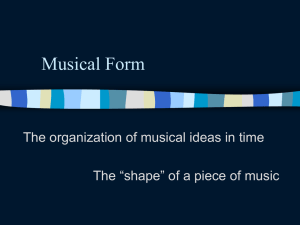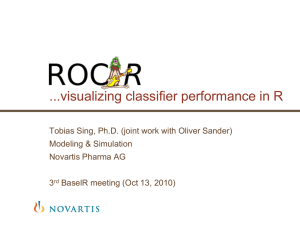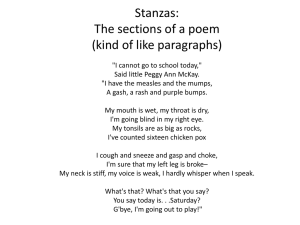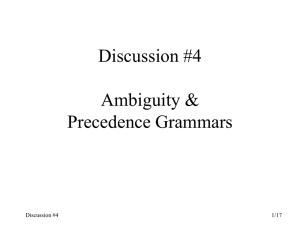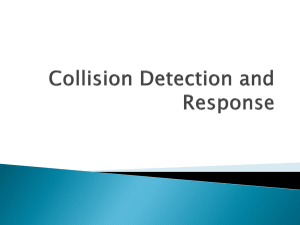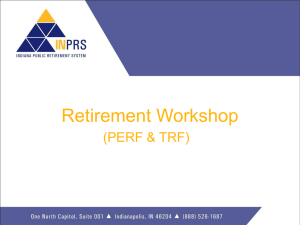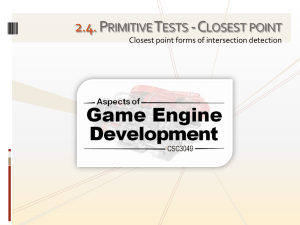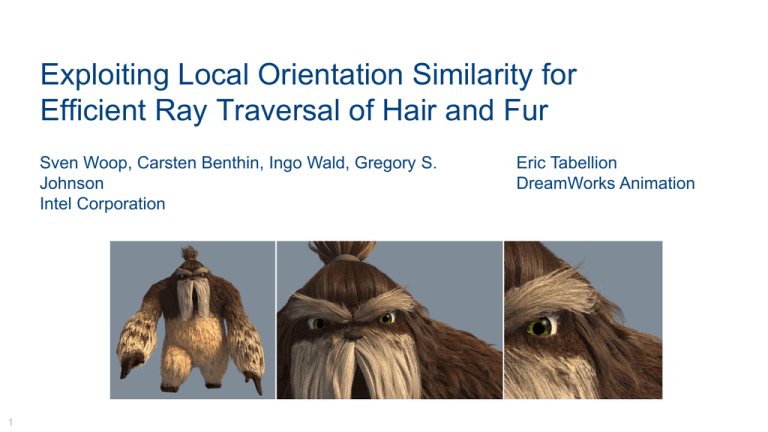
Exploiting Local Orientation Similarity for
Efficient Ray Traversal of Hair and Fur
Sven Woop, Carsten Benthin, Ingo Wald, Gregory S.
Johnson
Intel Corporation
1
1
Eric Tabellion
DreamWorks Animation
Legal Disclaimer and Optimization Notice
INFORMATION IN THIS DOCUMENT IS PROVIDED “AS IS”. NO LICENSE, EXPRESS OR IMPLIED, BY ESTOPPEL
OR OTHERWISE, TO ANY INTELLECTUAL PROPERTY RIGHTS IS GRANTED BY THIS DOCUMENT. INTEL
ASSUMES NO LIABILITY WHATSOEVER AND INTEL DISCLAIMS ANY EXPRESS OR IMPLIED WARRANTY,
RELATING TO THIS INFORMATION INCLUDING LIABILITY OR WARRANTIES RELATING TO FITNESS FOR A
PARTICULAR PURPOSE, MERCHANTABILITY, OR INFRINGEMENT OF ANY PATENT, COPYRIGHT OR OTHER
INTELLECTUAL PROPERTY RIGHT.
Software and workloads used in performance tests may have been optimized for performance only on Intel
microprocessors. Performance tests, such as SYSmark and MobileMark, are measured using specific computer
systems, components, software, operations and functions. Any change to any of those factors may cause the results to
vary. You should consult other information and performance tests to assist you in fully evaluating your contemplated
purchases, including the performance of that product when combined with other products.
Optimization
Notice
Copyright
© , Intel
Corporation. All rights reserved. Intel, the Intel logo, Xeon, Core, VTune, and Cilk are trademarks of
Intel
Corporation
in theorU.S.
countries.
Intel’s
compilers may
mayand
not other
optimize
to the same degree for non-Intel microprocessors for optimizations that are not
unique to Intel microprocessors. These optimizations include SSE2, SSE3, and SSSE3 instruction sets and other
optimizations. Intel does not guarantee the availability, functionality, or effectiveness of any optimization on
microprocessors not manufactured by Intel. Microprocessor-dependent optimizations in this product are intended for use
with Intel microprocessors. Certain optimizations not specific to Intel microarchitecture are reserved for Intel
microprocessors. Please refer to the applicable product User and Reference Guides for more information regarding the
specific instruction sets covered by this notice.
Notice revision #20110804
2
2
Challenges of Hair Geometry
• Path Tracing hair requires high sampling rates to reduce noise and aliasing
Our approach helps by improving traversal performance
• Long and thin structures are challenging to bound using AABBs
Our approach uses oriented bounding boxes to produce much tighter bounds
• Many million hairs are common (in particular for furry animals)
We use direct ray/hair intersection to keep memory consumption low
(tesellation impractical because of high memory consumption)
3
3
Previous Work
• Path Tracing Hair
• [Moon and Marschner 2006]: Simulating Multiple Scattering in Hair Using a Photon Mapping Approach
• [Ou et. al. 2012]: ISHair: Importance Sampling for Hair Scattering
• Oriented Bounding Box (OBB) Hierarchies
• [Gottschalk et. al. 1996]: OBB-Tree: A Hierarchical Structure for Rapid Interference Detection
• [Lext and Akenine-Möller 2001]: Towards Rapid Reconstruction for Animated Ray Tracing
• OBBs used in commercial renderers
• Ray/Curve Intersection
• [Sederberg and Nishita 1990]: Curve Intersection using Bezier Clipping
• [Nakamaru and Ohno 2002]: Ray Tracing for Curve Primitive
4
4
Hair Representation
p0/r0
• Hair subdivided into individual hair segments
(done in application)
• Hair segments represented as cubic bezier curves
(4 control points) with interpolated radius (4 radii)
5
5
p1/r1
p2/r2
p3/r3
Bounding Representations
• Axis Aligned Bounding Box (AABB):
lower and upper bounds in x,y,z in world space
• Oriented Bounding Box (OBB):
lower and upper bounds in x,y,z in rotated space
6
6
Bounding Diagonal Hair Segment
Axis aligned bounds
7
7
Oriented bounds
loose
tight
many false
positives
few false positives
Bounding Diagonal Hair Segments
Axis aligned bounds
8
8
Oriented bounds
significant overlap
minimal overlap
many traversal steps
few traversal steps
Local Orientation Similarity
• Neighboring hairs exhibit natural similarity in orientation
• For real hair, collisions cause similar orientation
• Synthetic hair mostly mimics real hair
9
9
Bounding Groups of Similarly Oriented Hairs
• Groups of equally oriented hair segments are
effectively bounded by OBBs
OBB hierarchy efficient for similarly oriented hair
segments
10
10
Our Approach
• Use mixed AABB/OBB hierarchy with fast direct
ray/curve intersection
good
• Exploits local orientation similarity to be efficient.
• No advantage for random hair distributions.
no advantage
11
11
Mixed AABB/OBB Hierarchy
• 4 wide Bounding Volume Hierarchy to make
effective use of 4-wide SSE
... ... ...
• Node types
• AABB nodes store 4 AABBs plus 4 child references
• OBB nodes store 4 OBBs plus 4 child references
• Leaf nodes store short lists of individual cubic bezier
curves
• Triangles handled in separate BVH simplifies
the implementation.
12
12
...
...
...
AABBs versus OBBs
• OBBs bound better, but more expensive tradeoff
• Towards the root AABBs are best as hair segments are small relative
to bounding box
• Towards the leaves OBBs are best as oriented bounds can tightly
enclose hair strands
Few nodes store AABBs and many OBBs
Many AABB nodes and few OBB nodes get traversed
Performan
ce
13
13
AABB
only
OBB
only
AABB+OB
B
100%
146%
186%
Uncompressed OBB Nodes
• Stores 4 OBBs in Struct of Array Layout
for effective use of SSE
• OBB stored as affine transformation
(3x4 matrices) that transforms OBB to
unit AABB
• Fast ray/OBB intersection by first
transforming ray and then intersecting
with unit AABB
• Requires 224 bytes per node
about 2x the size of an AABB node
14
14
struct UncompressedOBBNode
{
float[4] matrix[3][4];
Node* children[4];
}
Compressed OBB Nodes
• Stores one shared quantized
(signed chars) rotation that
transforms the OBBs to AABBs
• Stores merged AABBs (after
rotation) of all 4 children using
floating point
• Stores quantisized (unsigned
chars) AABBs of each child
relative to merged AABB
• Requires only 96 bytes per node
(less than half of uncompressed)
15
15
struct CompressedOBBNode
{
char matrix[3][4];
float min_x,min_y,min_z;
float max_x,max_y,max_y;
uchar cmin_x[4],cmin_y[4],cmin_z[4];
uchar cmax_x[4],cmax_y[4],cmax_z[4];
Node* children[4];
}
AABB/OBB Hierarchy Construction
• Traditional top down build using SAH heuristic [Wald 2007]
• Handling lists of bezier curves (not lists of bounding boxes)
control points needed for spatial splits
control points allow to compute precise bounds in different spaces
• Use lowest SAH split from multiple splitting heuristics
• Some splitting heuristics operate in a special hair space
• Spatial splits [Stich et. al.; Popov et. al.] can make the approach more robust
by handling challenging cases
16
16
Split Heuristics
• AABB Split Heuristics
• Object Binning (16 bins) in world space
• Spatial Splits (16 bins) in world space
• OBB Split Heuristics
• Object Binning (16 bins) in hair space (most important)
• Spatial Splits (16 bins) in hair space
• Similar Orientation Clustering
17
17
Hair Space
• Hair space used for binning and calculating OBBs
of nodes
y
• Hair space is a coordinate space with one axis
well aligned with a set of hair curves
x
good
• Only rotations used to be area preserving
• Calculation
• calculate candidate spaces (4 in the paper) aligned
with main direction (start to end point) of random hairs
• pick space where sum of surface areas of bounding
boxes of hair is smallest
bad
18
18
Similar Orientation Clustering
• Can separate two crossing hair strands
No single hair space will work well
A
• Calculation
• pick random hair A
• pick hair B that is maximally misaligned with hair
A
• cluster according to main direction of hairs A and
B
• bound clusters according to space aligned with
main direction of A and B
19
19
• Gives about 5% higher rendering
B
4-wide AABB/OBB Hierarchy Construction
• Split multiple times to fill up all 4 children
(pick largest node or node with highest SAH gain)
• If only „AABB heuristic“ splits create AABB node
• If one split was an „OBB heuristic“ split create OBB node and
store OBB aligned with hair space computed for each child
SAH decides where to use which node type
20
20
AABB/OBB Hierarchy Traversal
• Modified highly optimized BVH4 single ray traversal kernel of Embree
• Kept fast path for AABB node handling
• Added slow path for OBB node handling
• Added fast ray/hair segment intersection
21
21
Ray-Hair Segment Intersection
p0
• Use 8-wide AVX to generate 8 points on curve in parallel
using precalculated Bezier coefficients a,b,c,d:
p1
avxf p = a*p0 + b*p1 + c*p2 + d*p3
• Intersect ray using 8-wide AVX in parallel with 8 line
segments using test by [Nakamaru and Ohno 2002]
p2
• 8 segments work well for our models
rarely very curved hair segments need pre-subdivision
p3
22
22
Benchmark Settings
• Dual Socket Intel® Xeon® E5-2697 (AVX2, 2x 12 cores @ 2.7 GHz, 64GB
memory)
• 1M pixel resolution, path traced including shading (50% shading, 50% tracing)
• Representative movie content from Dreamworks
Tighten
420k triangles
2.2M curves
23
23
Tiger
83k triangles
6.5M curves
Sophie
75k triangles
13.3M curves
Yeti
82k triangles
153M curves
Results
AABBs
triangles
AABBs
curves
AABB/OBBs
curves
+ spatial
splits
+
compression
Perf.
3.5fps
3.7fps
6.6fps
7.5fps
7.3fps
Mem.
1.1GB
257MB
387MB
633MB
404MB
Perf.
1.44fps
1.0fps
2.1fps
2.7fps
2.5fps
Mem.
3.5GB
0.8GB
1.1GB
1.8GB
1.1GB
Perf.
4.2fps
3.5fps
7.1fps
7.3fps
7.1fps
Mem.
6.8GB
1.6GB
2.1GB
3.3GB
2.7GB
Perf.
-
1.8fps
2.6fps
3.1fps
3.2fps
Mem.
-
18.6GB
21.7GB
34.4GB
24.9GB
Measured on Dual Socket Intel® Xeon® E5-2697, 12 cores @ 2.7 GHz
24
24
Results: Using Ray/Curve Intersector
AABBs
triangles
AABBs
curves
AABB/OBBs
curves
+ spatial
splits
+
compression
Perf.
3.5fps
3.7fps
6.6fps
7.5fps
7.3fps
Mem.
1.1GB
257MB
387MB
633MB
404MB
Perf.
1.44fps
1.0fps
2.1fps
2.7fps
2.5fps
Mem.
3.5GB
0.8GB
1.1GB
1.8GB
1.1GB
Perf.
4.2fps
3.5fps
7.1fps
7.3fps
7.1fps
Mem.
6.8GB
1.6GB
Perf.
-
1.8fps
Mem.
-
18.6GB
2.1GB
3.3GB
Using our ray/curve intersector
2.6fps performance
3.1fpsby 15%
reduces
at 1/4th the memory
21.7GB
34.4GB
consumption
Measured on Dual Socket Intel® Xeon® E5-2697, 12 cores @ 2.7 GHz
25
25
2.7GB
3.2fps
24.9GB
Results: Triangles Consume too much Memory
AABBs
triangles
AABBs
curves
AABB/OBBs
curves
+ spatial
splits
+
compression
Perf.
3.5fps
3.7fps
6.6fps
7.5fps
7.3fps
Mem.
1.1GB
257MB
387MB
633MB
404MB
Perf.
1.44fps
1.0fps
2.1fps
2.7fps
2.5fps
Mem.
3.5GB
0.8GB
1.1GB
1.8GB
1.1GB
Perf.
4.2fps
7.3fps
7.1fps
Mem.
6.8GB
3.3GB
2.7GB
Perf.
-
3.5fps
7.1fps
Out of memory,
even
with 64GB of memory
1.6GB
2.1GB
and tessellation into
only 8 triangles.
1.8fps
2.6fps
3.1fps
3.2fps
Mem.
-
18.6GB
34.4GB
24.9GB
Measured on Dual Socket Intel® Xeon® E5-2697, 12 cores @ 2.7 GHz
26
26
21.7GB
Results: Adding OBBs
AABBs
triangles
AABBs
curves
AABB/OBBs
curves
+ spatial
splits
+
compression
Perf.
3.5fps
3.7fps
6.6fps
7.5fps
7.3fps
Mem.
1.1GB
257MB
387MB
633MB
404MB
Perf.
1.44fps
1.0fps
2.1fps
2.7fps
2.5fps
Mem.
3.5GB
0.8GB
1.1GB
1.8GB
1.1GB
Perf.
4.2fps
3.5fps
7.1fps
7.3fps
7.1fps
Mem.
6.8GB
1.6GB
2.1GB
3.3GB
2.7GB
Perf.
-
1.8fps
2.6fps
Mem.
-
18.6GB
21.7GB
Measured on Dual Socket Intel® Xeon® E5-2697, 12 cores @ 2.7 GHz
27
27
adding
3.1fps OBBs gives
3.2fps
80% speedup for
34.4GB
24.9GB
30% higher memory
consumption
Results: Adding Spatial Splits
AABBs
triangles
AABBs
curves
AABB/OBBs
curves
+ spatial
splits
+
compression
Perf.
3.5fps
3.7fps
6.6fps
7.5fps
7.3fps
Mem.
1.1GB
257MB
387MB
633MB
404MB
Perf.
1.44fps
1.0fps
2.1fps
2.7fps
2.5fps
Mem.
3.5GB
0.8GB
1.1GB
1.8GB
1.1GB
Perf.
4.2fps
3.5fps
7.1fps
7.3fps
7.1fps
2.1GB
3.3GB
2.7GB
2.6fps
3.1fps
3.2fps
21.7GB
34.4GB
24.9GB
Mem. spatial
6.8GBsplits give
1.6GB
15% speedup for
Perf.
1.8fps
60% higher memory
consumption
Mem.
18.6GB
Measured on Dual Socket Intel® Xeon® E5-2697, 12 cores @ 2.7 GHz
28
28
Results: Adding Compression
AABBs
triangles
AABBs
curves
AABB/OBBs
curves
+ spatial
splits
+
compression
Perf.
3.5fps
3.7fps
6.6fps
7.5fps
7.3fps
Mem.
1.1GB
257MB
387MB
633MB
404MB
Perf.
1.44fps
1.0fps
2.1fps
2.7fps
2.5fps
Mem.
3.5GB
0.8GB
1.1GB
1.8GB
1.1GB
Perf.
4.2fps
3.5fps
spatial splits and
Mem. compression
6.8GB
1.6GB
give
13% speedup for
Perf.
1.8fps
similar memory
Mem. consumption
18.6GB
7.1fps
7.3fps
7.1fps
2.1GB
3.3GB
2.7GB
2.6fps
3.1fps
3.2fps
21.7GB
34.4GB
24.9GB
Measured on Dual Socket Intel® Xeon® E5-2697, 12 cores @ 2.7 GHz
29
29
Video
• Path tracing with up to 10 bounces @ about 1M pixels
• 2x Intel(R) Xeon(R) CPU E5-2687W @ 3.10GHz (16 cores
total)
30
30
Conclusion and Future Work
• AABB/OBB hierarchy gives almost 2x speedup for hair geometry
• Need to improve build performance currently 20x slower than building
standard BVH over curve segments
• Handling triangles in same BVH could give additional benefit.
• Support for Motion Blur is important for movie rendering.
31
31
Questions?
Source code for Xeon and Xeon Phi
available as part of Embree 2.3.1,
https://embree.github.com
32
32


